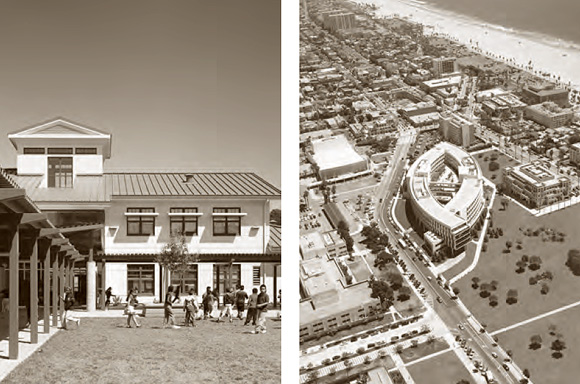
The cool detachment Marlon Brando demonstrated when, in 1973, he refused his Academy Award on political principles has, I believe, spread the notion in the minds of creative individuals that industry awards are a product of a mainstream establishment that praises mediocrity over creative experimentation, that they are a trite celebration of self-indulgence and vanity.
Therefore, I expected to find a large skeptical lot in the creative bunch of architects I asked about design award competitions. To my surprise, the tangible benefits of entering awards programs (not even necessarily winning them) were many, and, more surprisingly, the architects’ enthusiasm for them countered all of my instincts.
To get the broadest possible range of opinions, I asked several architects from across the country, from firms large and small, corporate and crazy, AIA members and non, and they all said good things. Of course, it could be the statistical skew of my own Rolodex, but nevertheless what they had to say was pretty convincing.
Firm principals almost uniformly believe winning awards is crucial to building a practice, that the need to engage is a simple reality, an implicit part of how successful practices are perceived. For both HOK and WWCOT in Los Angeles, the main goal in winning awards is recruiting and retaining talent. Annie Chu, AIA, of Chu+Gooding Architects extends that to the entire project team: “It’s a pat on the back for the project team. It’s always a miracle when a project gets completed, and an award is a good way of acknowledging all the efforts from owners to consultants, to fabricators and builders.” Adrienne Cress of Moody Nolan in Columbus, Ohio, has a very literal view of the award being recognition of the client’s contribution. “Moody Nolan carefully listens to the client’s vision and objectives and responds with creative design solutions. In reality, each project is designed by the client, with Moody Nolan translating and facilitating the client’s goals. Our design awards reveal a clear reflection of the close and successful collaboration between Moody Nolan designers and the client.”
The visibility that goes with winning an award seems to be a crucial component to the firm-building effort. Articles in magazines and newspapers are seen by clients and users, they become marketing materials in the firm’s press kit, and they build credibility with a larger professional community. Jonathan Segal, FAIA, of San Diego thinks it can “bring someone from total obscurity to the forefront. A small, well-thought-out remodel might help launch a career if they got an award for it.”
There is always a question of whether design awards given by architects to architects are anything more than a closed forum for mutual admiration. As Michael Chung of LETTUCE in Los Angeles kiddingly suggests, “Maybe we all have really low self-esteem and need public validation to feel good about ourselves.” Undoubtedly, but that does not preclude the process from having a ripple effect outside the profession, particularly when the awards get published. Segal believes having the winners published in the San Diego newspaper gives the firm a leg up with the public. “The community pays attention,” he says. “I hope that when we go for a community review of one of our projects it influences their decisions. I don’t know, but it has to help.”

Annie Chu says that awards are a marketing tool for some of their non-profit clients, who benefit from the exposure and bragging rights to their boards and supporters. It seems winning an award is not all about the architect’s ego.
Aside from having an award published, how can a fairly insular process help an architect get work? Ask Larry Scarpa, AIA, of Pugh+Scarpa: “Most architects underestimate the importance of marketing to our peers. If you look at any significant commission (and many not so significant), an architect is usually involved either directly in the selection process or is involved in some kind of advisory role, which ultimately results in one’s being asked to submit a proposal, interview for a project, or get a commission directly. One of the major ways for architects to gain exposure is through the recognition of being an award winner. The only reason that we submit for awards and publications is to be on the radar of selection committee members and therefore in a position to be viable contenders for the best architectural commissions. Prestige, cool certificates, staff recognition, something to brag about to clients? Those I care nothing about.”
According to Susan Grossinger, Senior Vice President at HOK Los Angeles, design award credentials are part of the selection criteria of many of the high profile clients they pursue. At Chu+Gooding, most of their clients expect to work with award winning firms, and RFQs from university clients specifically request a list of awards. Leo Marmol, FAIA, of Marmol Radziner believes that, from awards judged by their peers, institutional clients can be assured that Marmol Radziner’s unusual design/build method of practice benefits the quality of their architecture. For architects pursuing institutional work, the award certificate is mandatory, and the more the better.
Segal can’t point to one specific overriding reason to enter awards programs, but he finds the awards process to be fun and, in the end, validating. “For us, awards are very important. We are developers, we have no clients, so it’s not to help us get clients, but for us it creates credibility with our peers. It’s very expensive, but the byproduct is that you start to document your work, which is very important. There are all these tangential things that happen, like I’m speaking around the country. I have to think it’s partly because we got some awards. I’m giving a seminar. If I were some hack architect doing shitty work, no one would come. It must have helped me get my AIA Fellowship. It all adds up. You can’t say it does any one thing. We have won five national AIA awards and twenty local awards. We got nothing at California this year. It’s really hit and miss, but we find it invigorating and rewarding when we win.”

Looking at good design and engaging in a dialogue about design seems to be a yearning we do not leave behind us in the classroom crit. Thomas Bercy from Austin, Texas’s avant garde Bercy Chen Studio: “We typically enter design award competitions to have feedback on our work. It’s like when you were in school. You spent all this time designing, but where you really learned was when it was being discussed. It’s good to get out there to get an honest critique. We rely on jurors or committees to help us better understand the reaction our work creates.” Kate Diamond, FAIA, principal at NBBJ, Seattle, says that, while the structure of the competition might be flawed, the conversation itself is the value of design awards. Design awards provoke “a genuine interest in engaging one’s peers in the discourse and elevation of the art of architecture. Are we cynical about award programs because so many seem to be beauty pageants? Can a jury that flies in for one day and only experiences the design through exquisite, but not necessarily accurate, photographs gain valuable insights into the relative value of a set of projects? I can only tell you that I have participated in awards programs from both sides of the table—as a juror and as an award winner—and, while I want them to evolve to consider a richer set of criteria, I always learn something from the process. Award programs for all their flaws are an important part of the discourse of our profession.”
Like the lure of a podium finish in a sporting event, the scrutiny of a jury and having one’s work publicly displayed provides just the pressure necessary for some architects to push themselves that much harder. Chung is unabashed: “Part of the desire stems from the fact that by and large we designers are competitive animals. We like to be challenged, and we like to win.”
The $64,000 question remains: Can design awards improve the overall quality of design? Chung is unequivocal: “One of the huge values of the process of entering awards competitions is it focuses us and holds us accountable to the design ideals we purport to hold. We like that. Short of that, the process of making up bullshit to spin a crap-project into high design will force designers to confront the value of their own work.”
Ken Cook, executive in charge of brand integration at Publicis/Hal Riney, who juried this year’s Spark Awards, is quite clear on the topic. “The measure for any good design is an idea that took courage. Thus recognizing it might just provide courage to more product managers and CMOs. I’d like to meet a few more [courageous ones] before I die, and it’s these competitions that provide the backbones that support good solutions.”
Imagine the power well-conceived and well-publicized awards programs can have to help architects improve the built environment. Ideas that take courage, accountability to design ideals, rewarding good workers, furthering the conversation, building a successful practice, invigorating fun—these are the words of the participants. Would the skeptics like to weigh in?

Author Ann E. Gray, FAIA, is the founder of Balcony Media Inc., publishers of FORM magazine, and architectural books and monographs under the Balcony Press imprint including The Last Remaining Seats, Iron: Erecting the Walt Disney Concert Hall and LA’s Early Moderns. She is a licensed architect and practiced architecture in Los Angeles for 15 years, the last eight as Paramount Pictures’ studio architect. The architectural work under her tenure was recognized by TIME, Progressive Architecture and Interiors magazines. She is a former board member of the Hollywood CRA Design Review Committee, a Trustee of the California Preservation Foundation, and former president of USC’s Freeman House Associates. She has been on countless award juries for the AIA and other organizations, and she currently chairs the AIACC Design Awards Committee.
Originally published 3rd Quarter 2007, in arcCA 07.3, “Comparing Awards.”





